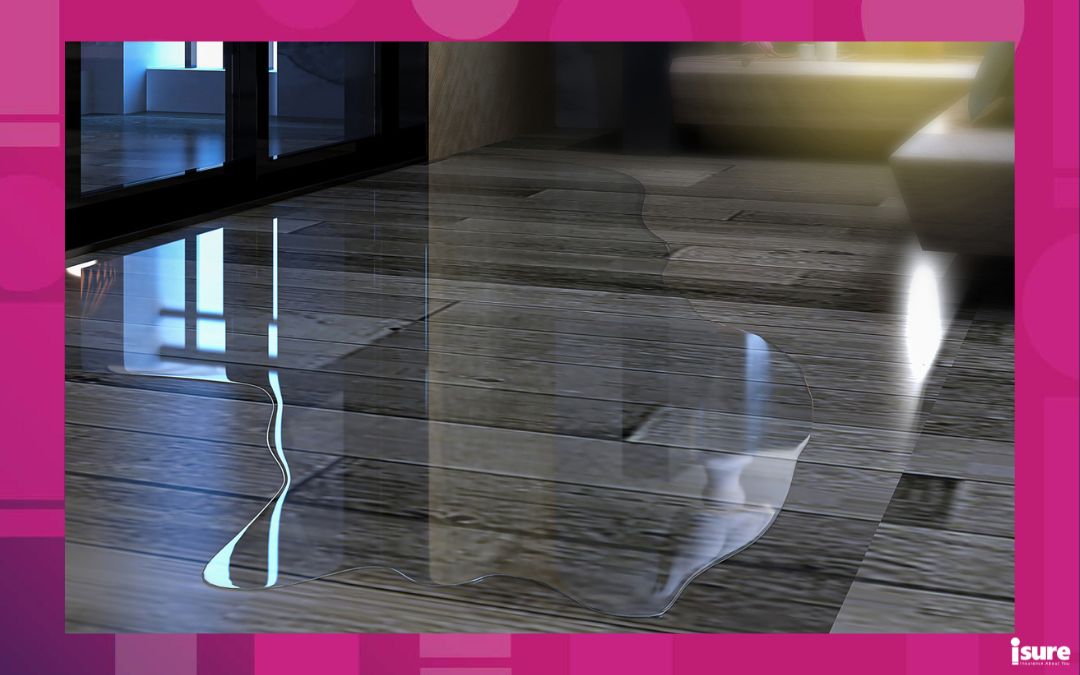Water damage is now the most common type of home insurance claim in Canada, and when a pipe bursts, a roof leaks or a basement floods, it’s a costly headache for everyone involved. But don’t panic! There are many things you can do to reduce the risk of water damage and a flood insurance claim.
In today’s world of extreme weather events, IBC.ca reports that nearly $2 billion dollars has become the new normal for yearly catastrophic losses – most of this is due to water-related damage. Nationally, spending on flood-related damage accounts for 75% of all weather-related expenditures. What you may not know is that a standard home policy doesn’t always cover damage caused by water that enters your home from heavy rains, sewer backups or sump pump failures. Let’s explore what is and isn’t covered in your policy.
What is flooding?
Flooding is defined as the result of heavy or prolonged rainfall, snowmelt or a combination of both. Sudden severe thunderstorms can cause flooding, particularly in urban watersheds. High water levels and/or high winds on the Great Lakes can also result in shoreline flooding. It is crucial that you perform seasonal checks both inside and outside your home. While you can’t control Mother Nature, you can prevent your home from damages caused when the temperature dips by being mindful of the following things:
Drainage from your roof and water damage
Heavy snowfall can damage your home’s roof, walls and foundation — flat roofs are especially vulnerable to collapse due to buildup. Sloping roofs create ideal conditions for ice dams. Dams can tear off gutters, loosen shingles and cause water to back up and pour into your house. When that happens, the results aren’t pretty — think peeling paint, warped floors, and stained or sagging ceilings.
It is important to clean your eavestroughs and ensure that the downspouts stay clear. Downspouts are intended to move water from your eavestroughs to a more absorbent surface at least six feet away from your home, like your lawn or garden. If redirecting your downspouts, avoid sending water to your driveway or sidewalk as it can ice over in the winter and create a different kind of hazard.
Cleaning leaves and debris out of your eavestroughs at least once a year can avoid clogging. Clearing it yourself can be dangerous; if you live in an area hit hard by snowfall, it’s worth hiring a licensed contractor to come by and clear your roof, gutters and downspouts of snow, ice, and debris.
TIP: Insulate your attic floor but keep the attic itself cool and well ventilated. That way, heat doesn’t rise from the house and melt the snow on the roof, avoiding ice dams.
Protect your pipes from water damage
One of the single biggest winter hazards for homeowners is flooding from frozen burst pipes. Not surprisingly, they are also one of the most expensive to fix. Sudden and accidental bursting of plumbing pipes and appliances is covered by all home insurance policies. However, damage may not be covered when freezing causes the escape of water. If the seal on your dishwasher or the hose leading to your washing machine suddenly breaks, you’ll be covered. On the other hand, if you’ve been ignoring a slow leak for months and now the colder weather has caused the leaked water to freeze and damage to your pipes, you won’t receive coverage.
If you are leaving your home unattended to travel, make sure you turn off the water at the source and drain the pipes. Unexpected power outages can cause indoor temperatures to dip, so we suggest having a friend or family member check on your home periodically. Some insurers will void your coverage if you leave your house empty and unmonitored for more than four consecutive days. Check with your isure broker to understand the conditions of your policy.
TIP: Wrap insulation sleeves around pipes in unheated or outdoor areas. Also, drain any exterior pipes and remove hoses to prevent ice buildup. Check the main water shut-off valve twice a year to make sure it’s working.
Did you know? Installing backflow valves or plugs for drains, toilets and other sewer connections will help prevent sewer water from entering your home!
Leaks from the walls and foundation
Regular inspections around the inside and outside of your home can be a vital preventative measure to avoid water damage to your home. Inspect the exterior walls and foundation of your home for cracks and seal them up to prevent leaks. Make sure to shovel out window wells, outdoor stairwells and clear away snow from around your home’s foundation so that when it melts, the water won’t seep in.
FYI: Sealing cracks in your foundation walls and basement floors will help to reduce the risk of basement water damage. In most cases, existing cracks can be sealed from the inside of your home without having to dig around your foundation.
A proper ground slope is important for directing water away from your home. But over time, soil erosion can change the grading of the land and make the ground flat or even reverse the slope, causing water to pool in the soil around your foundation and basement window wells. Regular inspections each Spring can help spot the erosion. Adding topsoil to the low points or digging up and redistributing soil can help by evening out the grading.
Window wells, or wells dug outside a basement window, are shields that support the earth and block debris and moisture from reaching your basement windows. They can significantly improve drainage and help prevent windowsill rot. Besides installing wells, adding wells as inexpensive barriers will provide extra protection from water seeping into your basement and causing damage.
Did you know? Design your landscaping to allow water to run away from your house because diverting water from your home naturally — with sloping hills and strategically placed shrubbery — can help to keep your basement dry.
Water damage to the basement
Basements are the most susceptible area of your home to water damage, which is why maintenance in this area is key. Keep your hot water tank well-maintained and check for corrosion that may lead to leakage or bursting. If your home doesn’t already have one, consider installing a sump pump in your basement to prevent and control basement flooding by sucking water out of the sump basin and draining it away from your home.
Remember: Water damage in a basement due to a sewer backup is only covered if specific sewer backup coverage has been purchased. Installing a sump pump could get you a discount on your home insurance!
Did you know? Pouring fats, oils, and grease down your drains can build up and create blockages over time that can lead to a sewer backup? Dispose of these substances with your regular food waste.
To best minimize this risk, install a sewer backup valve and waterproofing. The addition of weeping tile along the foundation of your home to divert water away can also be beneficial. A weeping tile is a porous pipe used for underground water collection or discharge and when the pipe is draining, it “weeps”, or exudes liquids. It was named during a time period when drainpipes were made from terracotta tiles. All these measures can greatly reduce the chances of having to deal with water damage in your home.
Home insurance coverage against water damage
Historically in Canada, home insurance policies haven’t covered loss or damage caused by overland flooding, which occurs when bodies of fresh water, such as rivers or dams, overflow onto dry land. Coverage for overland water and sewer back-up must be purchased as additional protection (called “endorsements”).
Overland Water Coverage or “Flood Insurance”
Overland Water Coverage insures against losses such as:
- Rain accumulation on the surface that enters through basement windows or a crack in an above grade basement wall;
- Rain accumulation on the surface and entering through the garage door;
- Sewer backup due to heavy rain and surface water also entering the home;
- Sewer backup due to the overflow of a body of freshwater or lake (oceans are not covered!);
Many insurers can now offer you residential overland flood coverage. This coverage is optional and combined with sewer back-up coverage, which is also optional. Even if you don’t live by a lake or river, your home could still experience flood damage in a variety of different ways. Check with your isure representative on cost and availability for your home.
Did you know? One of the best ways to protect your irreplaceable personal objects is by storing them high and dry above the floor of your basement. As well, keeping a current home inventory will help you should you experience flooding damage and need to submit a claim.
Here’s a more detailed look at what is and isn’t typically covered in home insurance policies, according to the Insurance Bureau of Canada:
What’s covered
The key to water damage coverage is “sudden and accidental” incidents that are not caused by freezing, such as the following:
- Water damage caused by indoor plumbing, heating, or air conditioning emergencies, although the cost of repairing the source of the problem is not covered.
- Indoor or outdoor domestic appliances on your property (i.e. washing machines, dishwashers etc.), although the cost to repair the appliance is usually not covered.
- Broken water main.
- Wind and hail damage to exterior and interior.
What’s not covered
- Damage from freezing of indoor plumbing. If you’re away from your home for more than four consecutive days, during the normal hunting season, you must drain the plumbing or have your home checked daily to ensure that heat is maintained. If freezing-related damages do occur despite these precautions, it will be covered under most policies.
- Damage from freezing outside the home (i.e. melting or moving snow).
- Leaking roof.
Purchasing flood insurance
Read your policy carefully and consult with your insurance agent or broker about whether you should consider buying flood insurance. You can purchase overland flooding coverage if you live in an area designated as a flood zone. If you have an all-risk or comprehensive policy, there is coverage for all water damage, except those your insurer will specifically mention.
This coverage is priced based on the risk of overland water flooding in your area. If you’re in a low-risk area, it will cost less to add this coverage, and you can sometimes add overland protection at no cost if you have sewer back-up protection. If you are adding it on its own, you’re looking at about $10-$30 roughly per month. You must already carry Sewer Backup coverage to be eligible to add Overland Water Coverage. It is not a stand-alone coverage. If your basement is waterproofed, it can be even cheaper depending on your home insurance provider. However, if you live in a slightly riskier area – at the bottom of a hill, near a body of water, and in an area prone to heavier rainfall and snow – you could pay significantly more.
Remember: being proactive and conducting regular inspections of your home is the best way to avoid flood damage. Be sure to speak with an isure representative today to discuss insurance savings to be had by implementing these flooding prevention tips in your home.




